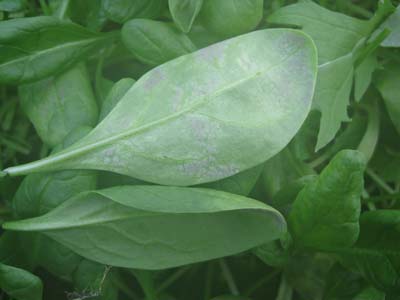 |
| Downy mildew on spinach |
Downy Mildew of Spinach
If you see this disease on your spinach crop, please respond with answers to the following question to help us develop a response, and future research.
1) Which varieties that you are growing are showing downy mildew?
2) If some of your varieties have downy and some do not, which varieties are not showing symptoms?
It has been called the “late blight of spinach” by Meg McGrath (plant pathologist with Cornell University). That is because the pathogen has a similar life history to that organism that causes late blight, AND because, similar to late blight, it is a community issue, not one only on your farm. The spores from the spinach downy mildew pathogen are released in vast quantities and can blow far when the conditions are right. In other words, everyone needs to be vigilant if we as a community are going to limit crop loss.
Here is a recent release from Dr. Margaret Tuttle McGrath
Plant Pathology and Plant-Microbe Biology Section, SIPS, Cornell University
Long Island Horticultural Research and Extension Center
3059 Sound Avenue, Riverhead, NY 11901; [email protected]
Downy mildew has been found recently in spinach at several farms in the northeastern U.S. This devastating disease has not been confirmed in the region for several years, thankfully as it has been a major production constraint in California. Pathogens causing downy mildew are Oomycetes and thus are related to the late blight pathogen. They are similar in ability to produce an abundance of wind-dispersed spores capable of moving long distances and to not need leaves to be wet to infect (high humidity is sufficient), plus ability to devastate crops.
All growers with spinach should inspect their plants for symptoms promptly NOW and also in spring plantings to catch if there is carry over or new outbreaks. If downy mildew is suspected, please contact your local extension specialist and send an e-mail to [email protected].
It will be CRITICAL that all high tunnel and overwintering spinach crops with downy mildew be destroyed couple weeks before the start of the spring spinach production season in the region to avoid carry over into 2017.
Symptoms. Purplish-gray, fuzzy growth of the pathogen, which is usually on the underside of leaves, is diagnostic. Early morning is the best time to see as the growth (which is spores and the structures holding them) is produced overnight, then during the day the spores are dispersed. On the top side of leaves, opposite where the growth develops, the leaf tissue will be yellow, initially dull becoming brighter and larger with time. Subsequently affected tissue will become dry and tan. If only leaf yellowing is seen, which could occur when humidity is low, put suspect leaves upside down on wet paper towel in a closed ziplock bag for a day. Keep the bag in the dark, such as inside a box, to further promote the pathogen if present to develop.
Management. Resistant varieties have been an important management practice, but the pathogen has proven adept at developing new races able to overcome host resistance. Last year race 16 was discovered.
To maximize success of control with fungicides, start early in disease development (preventive best), and apply weekly. Conventional fungicides for this disease include: Actigard, Aliette, Merivon, Quadris and other QoI fungicides, ProPhyt and other phosphorous acid fungicides, Ranman, Reason, Revus, Ridomil Gold, and Tanos. Downy mildew is difficult to manage with organic fungicides based on experience of researchers and growers in CA. Labeled products include copper, Actinovate, Double Nickel, Regalia, Oxidate, Trilogy, and Zonix. Copper is considered most effective but based on few evaluations of organic products. Check REI and PHI when selecting conventional or organic fungicides to make sure fits production schedule.
Note that while leaves are held in plastic bag after harvest, affected leaves may rot and new symptoms may develop, especially if there is residual moisture from washing.
Promptly destroy infected, abandoned crops to eliminate this source of inoculum for other plantings in the region. The pathogen can survive a few years in soil when both mating types are present together enabling production of oospores.
Other Susceptible Plants. The pathogen, Peronospora farinosa f. sp. spinaciae, is only known to infect spinach. It is possible some Chenopodium weed species are susceptible to some races.
Pathogen Sources. It is possible contaminated seed or infected spinach produce from outside the region was the source of the current outbreak.
Favorable Conditions. Cool with high humidity. Optimal temperature range for this pathogen is 59 – 70 F.
Please Note: Any reference to commercial products, trade or brand names is for information only; no endorsement is intended. The specific directions on fungicide labels must be adhered to – they supersede these recommendations, if there is a conflict. Check state registrations and labels for use restrictions.
Prepared 11/14/16
